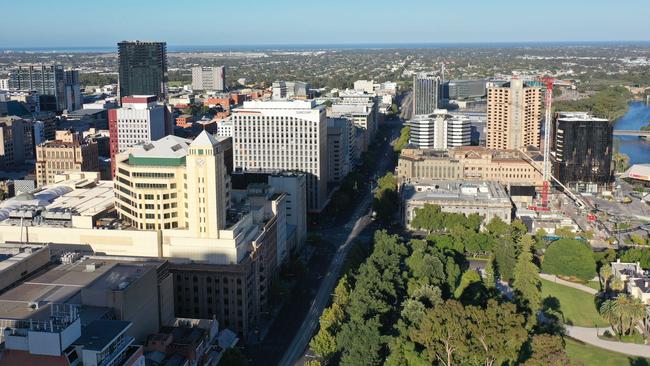Bruce Djite pitches plan to ensure Adelaide has a population of two million by 2030
Committee for Adelaide boss Bruce Djite says the city does not have enough people in it and must expand to two million people within a decade. Do you agree with him?
SA News
Don't miss out on the headlines from SA News. Followed categories will be added to My News.
Adelaide needs to grow to a city of two million over the next decade.
That’s the view of Committee for Adelaide chief executive and former soccer star Bruce Djite, who believes population growth is vital if the city wants to retain its young people and remain a vibrant place to live.
Adelaide has slipped from Australia’s third-largest city in the post-war era to fifth, overtaken by Perth and Brisbane. South Australia’s gross state product last financial year was $114.9bn, compared with $368.9bn in Queensland and $320.6bn in WA.
Mr Djite said there needed to be a rethink about what a population increase meant.

“People are like, ‘Hold on, we don’t want this in the West End because it will take away from the East End. There’s a restaurant opening here that will take people away from there’. And that is because there’s not enough people in this place,” he said.
Mr Djite said he believed a population of two million people by 2030 would help to secure employment and growth opportunities without compromising the city’s lifestyle.
“We just don’t have the critical mass, and I think we have the infrastructure – right now – for two million. If we want a thriving economy, we need to be two million by 2030. Why? More people want to go out, more people want to eat, more people want to shop,” Mr Djite said.
Adelaide could grow in three ways – by addressing the brain drain that had traditionally seen South Australians chase bigger opportunities on the East Coast, by attracting new people from interstate and through overseas migration, Mr Djite said.

“The challenge has been for years that there weren’t the jobs and opportunity in Adelaide, but the jobs are coming here now,” he said.
“In the last couple of years, we have started to accumulate that critical mass of jobs.
“And as for migration, people seem to have the view that there’s a finite amount of jobs and if you bring people in from overseas they’ll take that finite amount of jobs.
“The reality is that migrants create jobs, the more you bring the more jobs there will be.”
Mr Djite said with the pandemic inspiring Australians to look further than Sydney and Melbourne for new opportunities, Adelaide was uniquely placed to capitalise.
Hickinbotham Group managing director Michael Hickinbotham shares the sentiment.
“I think Covid provides unique opportunities for a place like Adelaide as people start to value different aspects of what we can offer,” said Mr Hickinbotham, who heads up South Australia’s biggest new home builder.

Mr Hickinbotham said that growth was vitally important for maintaining SA’s tax base and ensuring we stayed a vibrant place to live.
“We also need it due to the ageing of our workforce,” he said.
“We have the oldest or second-oldest trade base in the country. Everyone recognises that we have to grow, it’s just how we go about doing it.”
Mr Hickinbotham said the regional visa plan was a huge success for Adelaide when it was implemented, but that it had been somewhat watered down by the addition of other cities such as Perth to the scheme.
“Our population grew at a 40-year-high and we had seven strong years where that had a direct impact on our economy,” he said.
Mr Hickinbotham said people shouldn’t be afraid that a larger population would undermine the laid-back atmosphere that SA cherished.
“We can have both things,” he said.
“We’re not talking about exponential growth, we’re talking about measured, sustainable population growth.
“An extra 10,000 people a year would make a world of difference. It would inject so much energy and vitality into our state and it would be a wonderful thing.”
Premier Steven Marshall said sustainable population growth was good for the state, but would not commit to a target.
“We’ve made no secret of the fact that we do significantly want to grow our population in South Australia,” he said.
“We haven’t put a number on it yet. Our bicentenary is coming up in 2036 and I think we should be setting a number for our bicentenary.
“It’s good for the entire state, for attracting further investment into facilities in our state, giving our construction sector great opportunities, our hospitality, our tourism sector a lot of opportunity.”
Read related topics:Building a Bigger, Better SA



